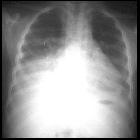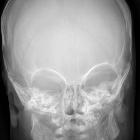bone within a bone appearance


Bone within a
bone appearance • Osteopetrosis - Ganzer Fall bei Radiopaedia

Bone within a
bone appearance • Bone within a bone - Ganzer Fall bei Radiopaedia

Bone within a
bone appearance • Osteopetrosis (primary) - Ganzer Fall bei Radiopaedia

Bone within a
bone appearance • Bone within a bone - Ganzer Fall bei Radiopaedia

Bone within a
bone appearance • Osteopetrosis - Ganzer Fall bei Radiopaedia
Bone within a bone is a descriptive term applied to bones that appear to have another bone within them. There are numerous causes including:
- normal
- thoracic and lumbar vertebrae (neonates and infants)
- growth recovery lines (after infancy)
- cortical splitting and new periostitis
- sickle cell disease/ thalassemia /Gaucher disease
- chronic osteomyelitis e.g. congenital syphilis, TB
- scurvy
- Caffey disease (infantile cortical hyperostosis)
- abnormal bone metabolism
- disordered bone growth
- heavy metal poisoning (bismuth, lead, thorium)
- hypervitaminosis D
- Thorotrast (ghost vertebrae)
- ionizing radiation
- radiation injury
- radiotherapy
- subcortical osteopenia
- leukemia, metastases
- complex regional pain syndrome (Sudeck atrophy)
- idiopathic juvenile osteoporosis
- oxalosis (intraosseous crystal deposition)
- iatrogenic
- bone graft, subcortical bone cement
- bisphosphonates
- radiotherapy
- bone healing
- artifact
- double exposure
A useful mnemonic to remember the etiologies is: GHOST DRAGON.
Siehe auch:
- Morbus Paget des Knochens
- Sichelzellenanämie
- Osteopetrose
- Akromegalie
- Thalassämie
- Morbus Gaucher
- Lues connata
- Infantile kortikale Hyperostose
- Thorotrast
- Hypervitaminose D
- heavy metal ingestion (bismuth, lead, thorium)
- Autosomal dominante Osteopetrose
und weiter:

 Assoziationen und Differentialdiagnosen zu Knochen-in-Knochen-Aspekt:
Assoziationen und Differentialdiagnosen zu Knochen-in-Knochen-Aspekt:







